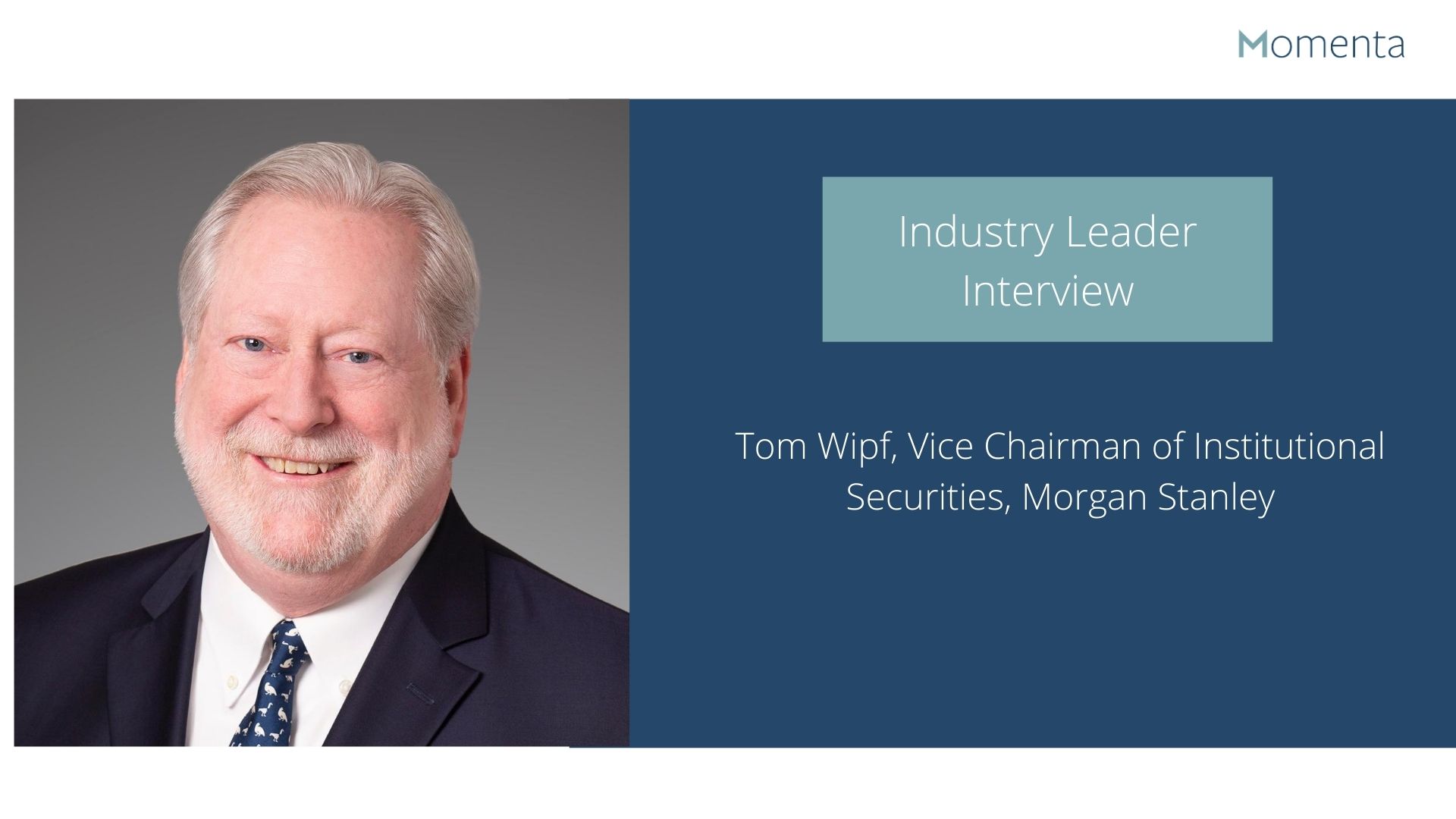Industry leader interview: Tom Wipf Vice Chairman of Institutional Securities, Morgan Stanley
Momenta sat down with Tom Wipf, Vice Chairman of Institutional Securities at Morgan Stanley and Chair of the Alternative Reference Rates Committee (ARRC), to discuss his views on the current LIBOR transition.
Can you tell us more about your experience in the market?
In my role at Morgan Stanley, I have been around the financing of businesses and products that are naturally impacted by LIBOR. When I joined the ARRC in 2014, I continued to focus on that work on behalf of our firm and for the ARRC. In May of last year, I was named chair of the ARRC and have been working closely with ARRC members – both from the public and private sectors – to ensure a successful transition away from LIBOR to a more robust reference rate, SOFR.
Can you explain the difference between SOFR and LIBOR and how this change will impact existing legacy products?
The big distinction is that LIBOR is a rate that, over time, has become based on expert judgments. Currently, there are 19-panel banks that make submissions to the LIBOR panel. Over time, the increase in use of LIBOR has created an inverse pyramid as there are not a lot of underlying transactions in the interbank market. LIBOR was supposed to reflect the interbank market, but that market has dwindled while the use of LIBOR has increased materially.
SOFR is a risk-free-rate that is based on underlying transactions in the US Treasury repo market and does not employ any method of expert judgment. It is collected from clearing banks and clearinghouses, administered by the New York Fed, and is based on over a trillion dollars of transactions per day.
What key issues will arise due to any disparities between LIBOR and its replacement?
Over the last couple of years, people have spent a lot of time focusing on the differences. From the ARRC’s perspective, the market has had several years to digest the distinctions between these two rates. Our initial goal was to recommend a rate that would be useful to market participants, based on real transactions, and that avoids some of the shortfalls that we see in LIBOR.
A key issue are tough legacy products, which don’t have the ability to be amended – like some floating-rate notes that lack commercially reasonable fallback language. The ARRC has produced a number of fallbacks that market participants can incorporate into their new products to mitigate this issue going forward. Additionally, the ISDA protocol will be coming out soon and will allow market participants to further address the legacy issue for derivatives. The most important and easiest action to take is to start using SOFR sooner rather than later, which many have done, in particular in the floating rate note market.
Could you explain the risk of failing agreements because of the cessation in LIBOR?
There has been a lot of progress in addressing this risk over the last several years. For those who continue to use LIBOR, it is critical to incorporate ARRC fallbacks and adhere to the ISDA protocol to create a smooth landing at the potential cessation of LIBOR.
Prior the ARRC’s work beginning in 2014, no documents were prepared for the permanent cessation of LIBOR. To date, there has been a lot of work done to allow market participants to embed certain fallbacks and adjustments in contracts that use LIBOR. While this is an achievement, there is still a stock of legacy product out there that lack commercially reasonable fallbacks.
Additionally, the ARRC is pursuing a legislative path in New York State that would help market participants insert ARRC fallback language into certain legacy documents. By no means should legislation override existing and reasonable contractual arrangements, either here or in the UK, but instead should provide an opportunity for the market participants to utilize substitute language where the contract has no fallback language or impractical fallback language.
What are the implications of the transition for asset classes and investors?
There are a number of different types of assets, like floating rate notes, perpetuals, and preferreds that may become fixed rate instruments using the last LIBOR reset as a coupon going forward. It is highly difficult to amend these types of contracts in the US post issuance. These types of contracts may experience valuation impacts as we move forward through the transition.
At the end of May, the ARRC released best practices articulating the suggested best path forward. First and foremost, we encourage market participants to start adopting SOFR sooner rather than later. For those who can’t, it’s important to have the right hardwired fallbacks in place to minimize your exposure to LIBOR and create the smoothest possible landing for legacy positions. Over the past few weeks, this has been reiterated by the public sector, specifically from President Williams of the New York Fed and Governor Bailey of the Bank of England. The best thing to do is for the industry and market participants to reduce exposure as best they can, through fallbacks and new production using new rates. We have the benefit of the next 17 months to reduce our risk positions as much as possible, and then address the remaining legacy contracts.
What does the transition mean for mortgages and other securitized products?
Every asset class from derivatives to loans is impacted. Securitized products are complex and may have a range of fallback language within the instrument. There has been an enormous amount of work done around these products, specifically within the US mortgage market. The Federal Housing Finance Agency and the GSE’s, including Fannie Mae, Freddie Mac and the Home Loan Bank System, have all been moving very aggressively to reduce exposures to LIBOR and increase new production of SOFR. By the end of this year, the GSE’s will stop taking LIBOR-based products and will accept SOFR mortgages, which is critical for the stability of the financial system.
We continue to hold to the highest standard of care for all consumer markets. The consumer market and US mortgage products will use the averages of SOFR, which are now posted on the Federal Reserve website. These are backward-looking averages that can be used in a compounded-in-advance product. This provides a really effective way to avoid all the necessary calculations involved with utilization of a compounded rate, and allows consumers and lenders to take a rate off the screen where it is transparent. I would say that the US mortgage products- traditional consumer loans, are in a really good place in terms of this transition.
As we look ahead to the next 17 months, it’s important for owners and issuers of these legacy securitized products to dig in and address their fallbacks. Once this is assessed, one can work to amend and repair the risk.
What is your main focus as you look forward to the transition?
Based on the comments from the public sector in July, there is no doubt, from both a regulatory and supervisory perspective, that the deadline of 12/31/21 will remain. We look forward to ISDA releasing its protocol, which will be helpful in addressing derivatives. It is important for market participants to adopt this protocol, as it provides a clear and transparent path forward for derivatives.
Lastly, I’m excited about all of the of tools now on the table that the industry can now benefit from – the ARRC best practices, ARRC fallback language, and the ISDA protocol that will soon be released. Pieces are starting to fit together in the puzzle, creating less uncertainty and hopefully aiding in advancing a successful transition.

